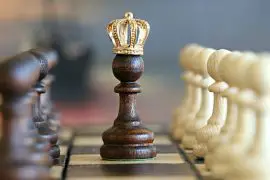Most people like to be on the white side in chess. This is because the player with the white pieces makes the first move. When you have the first move up your sleeve, there is a slight possibility that you will have an early advantage in the game.
So how to decide who is white in chess?
Contents
There is no official rule to decide who gets the white side in chess.

When playing chess informally, people usually select the color by concealing a chess piece of each color in each hand and giving their opponents a choice. They get the color they choose.
Players can also just let their opponents choose which color they want to play with.
They can also decide by flipping a coin, rolling dice, cutting cards, having a lottery etc.
However, things get more serious in real chess tournaments. Usually, tournaments will fix the colors players get when they draw the matches. The first player drawn is white, and the next player is black.
Some tournaments will decide by tossing a coin.
Does the color you get in chess really matter?
There is nothing to prove that getting the white side in chess will help you win the game. But most often, white is the preferred side because white always makes the first move.
Since tradition says that white should move first, it is important to determine an unbiased way to decide who gets white.

Some players really don’t care which side they get first. Luck has nothing to do with winning a game of chess. It’s all about being smart and calculated.
But other players take it very seriously because of the first-mover advantage.
What is the First Mover Advantage in Chess?
Most chess players and chess grandmasters believed in the advantage that being the white side in chess has to offer. They believed that it contributed a lot towards having a strong opening in the game.
But does this mean that being on the black side has more chances of losing?
When we review many chess games played in tournaments in the past, more than 52% of players who win are players with white pieces. White does seem to have a slight advantage statistically.

But this ‘First Mover Advantage’ has never really been proven.
We have regularly witnessed many players who have the black side and win. The first mover advantage is only slight if it is ever existent. And it does not in any way sideline the importance of intelligence and strategic thinking in a game of chess.
Should white always be the side to play first?
Traditionally, white was established as the side to start the game of chess. This was only made a rule for the sake of uniformity. There is nothing remotely racist in the decision and nothing to say that you can’t start the game with black.
White was not always the side that started the game of chess.
The rule came to be only in 1880 when the Fifth American Chess Congress decided that the color of the players must be decided before the match and that the first move must be made by white.
In 2019, Magnus Carlson and Anish Giri decided to break the rule due to its potential racist allusions. They played some games where black went first.
There is really no issue when starting the game of chess with the black side.
But starting with black does mean there will be some differences in tactics when starting the game with white. This is due to some slight differences in the set-up of the board.
Conclusion
How to decide who is white in chess? It does not really matter who starts the game first or who gets the white side in chess. There are many different ways to decide who gets the white side in an informal game of chess, like hiding a chess piece of each color in hand and having the opponent choose or tossing a coin.
Most players like playing with white pieces because white always makes the first move traditionally. Most chess players believe in the ‘First Mover Advantage’ of white. But it is not really the case. And black has won innumerable times in chess, so the advantage is never proven.
I think the white advantage is merely psychological than actually existent.
Also read: Can chess end in a draw?





